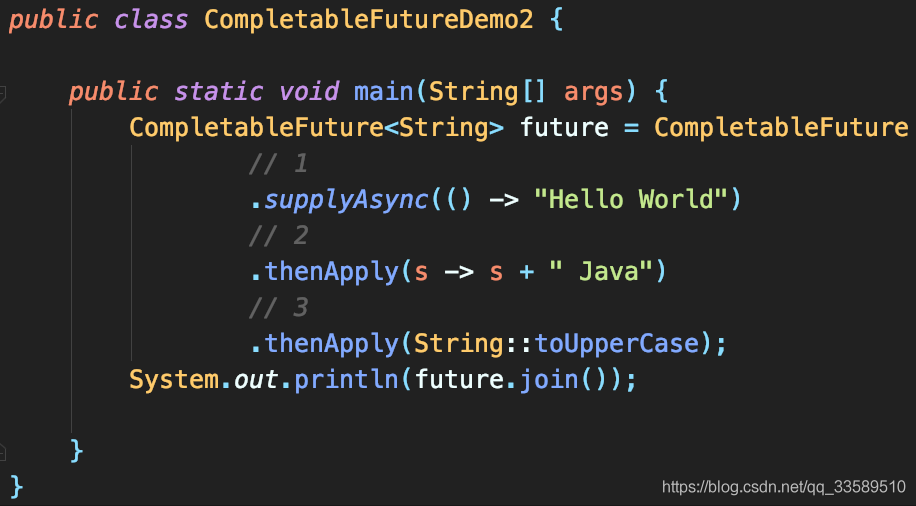手把手教学妹 CompletableFuture 异步化, 性能关系直接起飞!
System.out.println("T2:拿茶叶...");
sleep(1, TimeUnit.SECONDS);
return "龙井";
});
//任务 3:任务 1 和任务 2 完成后执行:泡茶
CompletableFuture<String> f3 =
f1.thenCombine(f2, (__, tf)->{
System.out.println("T1:拿到茶叶:" + tf);
System.out.println("T1:泡茶...");
return "上茶:" + tf;
});
//等待任务 3 执行结果
System.out.println(f3.join());
void sleep(int t, TimeUnit u) {
try {
u.sleep(t);
}catch(InterruptedException e){}
}
// 一次执行结果:
T1:洗水壶...
T2:洗茶壶...
T1:烧开水...
T2:洗茶杯...
T2:拿茶叶...
T1:拿到茶叶:龙井
T1:泡茶...
上茶:龙井
====================================================================================
创建 CompletableFuture 对象主要靠下面代码中展示的这 4 个
头两个使用默认线程池。
runAsync(Runnable runnable)
Runnable 接口的 run()方法没有返回值

supplyAsync(Supplier supplier)
Supplier 接口的 get()方法有返回值

CompletableFuture 默认使用公共的 ForkJoinPool 线程池,这个线程池默认创建的线程数是 CPU 的核数(也可以通过JVM option:-Djava.util.concurrent.ForkJoinPool.common.parallelism设置 ForkJoinPool 线程池的线程数)。
若所有 CompletableFuture 共享一个线程池,那么一旦有任务执行一些很慢的 I/O 操作,就会导致线程池中所有线程都阻塞在 I/O 操作上,从而造成线程饥饿,进而影响整个系统的性能。所以,推荐根据不同业务类型创建不同的线程池,以
避免互相干扰。下两个方法可指定线程池
runAsync(Runnable runnable, Executor executor)

supplyAsync(Supplier supplier, Executor executor)

创建完 CompletableFuture 对象后,会自动异步执行 runnable.run()或者 supplier.get(),对一个异步操作,我们关注:
异步操作什么时候结束
如何获取异步操作的执行结果
因为 CompletableFuture 类实现了 Future 接口,所以这些都是通过 Future 接口解决的。
CompletableFuture 类还实现了 CompletionStage 接口
================================================================================
任务有时序关系,比如
串行
比如烧水泡茶,其中洗水壶和烧开水
并行
洗水壶、烧开水和洗茶壶、洗茶杯这两组任务之间
汇聚
烧开水、拿茶叶这俩任务和泡茶就是汇聚
CompletionStage 接口可清晰描述任务之间的这种时序关系,例如
f3 = f1.thenCombine(f2, ()->{})
描述的就是一种汇聚关系。烧水泡茶中的汇聚关系是一种
AND 聚合关系
AND 指所有依赖的任务(烧开水和拿茶叶)都完成后才开始执行当前任务(泡茶)
还有
OR 聚合关系
OR 指的是依赖的任务只要有一个完成就可以执行当前任务。
CompletionStage 接口里面描述串行关系,主要是 thenApply、thenAccept、thenRun 和 thenCompose 这四个系列的接口。
thenApply 系

fn 的类型是接口 Function<T, R>,这个接口里与 CompletionStage 相关的方法是 R apply(T t)

该方法既能接收参数也支持返回值,所以 thenApply 系列方法返回的是CompletionStage<U>。
thenAccept 系

参数 consumer 的类型是接口Consumer<T>,这个接口里与 CompletionStage 相关的方法是
void accept(T t)

该方法虽然支持参数,但不支持返回值,所以 thenAccept 系方法返回值是 CompletionStage。
thenRun 系

参数是 Runnable,所以 action 既不能接收参数也不支持返回值,所以 thenRun 系列方法返回的也是CompletionStage<Void>。
Async 表示异步执行 fn、consumer 或 action。
thenCompose 系
这个系列的方法会新创建出一个子流程,最终结果和 thenApply 系相同。
看如何使用 thenApply()。
supplyAsync()启动一个异步流程,之后是两个串行操作。虽然这是一个异步流程,但任务 1、2、3 是串行执行,即 2 依赖 1 的执行结果,3 依赖 2 的执行结果。

主要是 thenCombine、thenAcceptBoth 和 runAfterBoth 系接口
主要是 applyToEither、acceptEither 和 runAfterEither 系接口
CompletionStage applyToEither(other, fn);
CompletionStage applyToEitherAsync(other, fn);
CompletionStage acceptEither(other, consumer);
CompletionStage acceptEitherAsync(other, consumer);
CompletionStage runAfterEither(other, action);
CompletionStage runAfterEitherAsync(other, action);
如何使用 applyToEither()描述 OR 汇聚关系。
CompletableFuture<String> f1 =
CompletableFuture.supplyAsync(()->{
int t = getRandom(5, 10);
sleep(t, TimeUnit.SECONDS);
return String.valueOf(t);
});
CompletableFuture<String> f2 =
CompletableFuture.supplyAsync(()->{
int t = getRandom(5, 10);
sleep(t, TimeUnit.SECONDS);
return String.valueOf(t);
});
CompletableFuture<String> f3 =
f1.applyToEither(f2,s -> s);
System.out.println(f3.join());
CompletableFuture 中各种关系(并行、串行、聚合),支持的各种场景。 比如:线程 A 等待线程 B 或线程 C 等待线程 A、B 。
其实 CountdownLatch、ThreadPoolExecutor 和 Future 就是来解决这些关系场景的,现在有了 completableFuture,可以优先考虑使用 CompletableFuture。
=====================================================================
fn、consumer、action 的核心方法都不允许抛受检异常,但无法限制它们抛运行时异常,例如下面的代码,执行 1/0 就会出现除 0 错误的运行时异常。
非异步编程里,可以用 try/catch 捕获并处理异常,异步编程里该如何处理呢?

CompletionStage 给出的方案很简单,使用这些方法处理异常和串行操作一样的,而且还支持链式编程。
CompletionStage exceptionally(fn);
CompletionStage<R> whenComplete(consumer);
CompletionStage<R> whenCompleteAsync(consumer);
CompletionStage<R> handle(fn);
CompletionStage<R> handleAsync(fn);
exceptionally()类似 try/catch 中的 catch

whenComplete()和 handle()类似 try/finally 的 finally,无论是否发生异常都会执行 whenComplete()中的回调方法 consumer 和 handle()中的回调方法 fn
whenComplete()不支持返回结果,handle()支持返回结果。
学了这么多,最后来看个例子:
//采购订单
PurchersOrder po;
CompletableFuture<Boolean> cf =
CompletableFuture.supplyAsync(()->{
// 在 MySQL 中查询规则
return findRuleByJdbc();
}).thenApply(r -> {
// 规则校验
return check(po, r);
});
Boolean isOk = cf.join();












评论